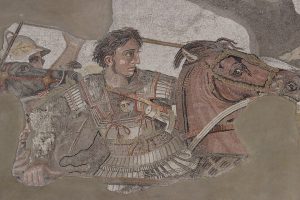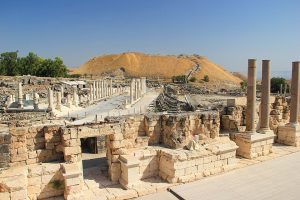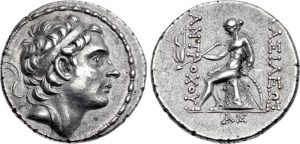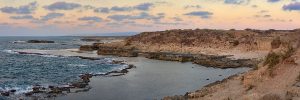The death of Alexander the Great in 325 B.C. is generally considered the beginning of a new era throughout the eastern Mediterranean and the Near East. During this period, several aspects of the life of various peoples were imbued with Greek civilization, art, technology, language, and philosophy.

Mosaic of the battle of Alexander the Great, from the House of the Faun in Pompeii. Naples, National Archaeological Museum
The process of Hellenization in the biblical lands did not develop in uniform fashion. It seems to have begun in Phoenicia and gradually spread southward through the coastal cities. Cities such as Akko (Ptolemais), Dor, Jaffa, and especially Ashkelon and Gaza in the south, awoke to the new cultural trends. In the inland regions, Hellenization was initially more intense in the center and north. The city of Samaria became a pioneer in the highlands of the central region. In the Jezreel Valley, the ancient Beth Shean was rebuilt under the name Scythopolis and became a major crossroads for trade relations between that area and the cities of the so-called Decapolis, which emerged on the eastern side of the Sea of Galilee and in the region beyond the Jordan.

Ruins of Beit Shean
Greek culture took root primarily in the sphere of commerce and in cities, while its influence was much less pronounced among the rural population, which largely continued to maintain its traditional way of life and customs.
The Hellenization of Judea was slower than in other regions. Jerusalem was initially respected. Later, and very gradually, it too began to transform its appearance in accordance with the trends of the time, and buildings representative of the new cultural patterns started to appear.
Moments of particular drama were experienced during the reign of Antiochus IV Epiphanes (175–164 B.C.), when the Hellenization of Jerusalem reached its peak. The city was transformed into a Hellenistic “polis,” the Torah ceased to be the constitutional law as it had been since the Persian period, and sacrifices and worship in the Temple were suppressed. Antiochus sent an expedition to Jerusalem and stationed military settlers there; their presence made Jerusalem a city with a mixed population of Jews and gentiles. Even the Temple was dedicated to the “Lord of Heaven,” basically equivalent to the Greek Olympian Zeus.

Coin of Antiochus IV Epiphanes
At the outset, his decrees were met with passive resistance from much of the Judean population. However, this passive resistance soon gave way to armed rebellion. A guerrilla force assembled, led by Judas Maccabeus; it achieved rapid successes and attracted a significant number of Jews discontented with the situation. After a series of victories, Judas occupied Jerusalem with his troops, purified the Temple, and rebuilt the altar. Nevertheless, the struggle continued. The uprising initially triumphed, but ultimately, they were defeated, and Judas died.
Sometime later, a group of rebels chose Jonathan as their leader, and upon his death, his brother Simon was selected as his successor; not only as military leader but also as High Priest. In 141 B.C., Simon secured the surrender of the last stronghold resisting him in the Jerusalem fortress, achieving complete national independence. In 140 B.C., an assembly of priests and commoners decided to legitimize Simon’s powers and make them hereditary. This act established a new dynasty, the Hasmonean. It would retain political and religious power over the country until the arrival of the Romans.
By don Francisco Varo, priest

Tel Dor by Iliakriv
